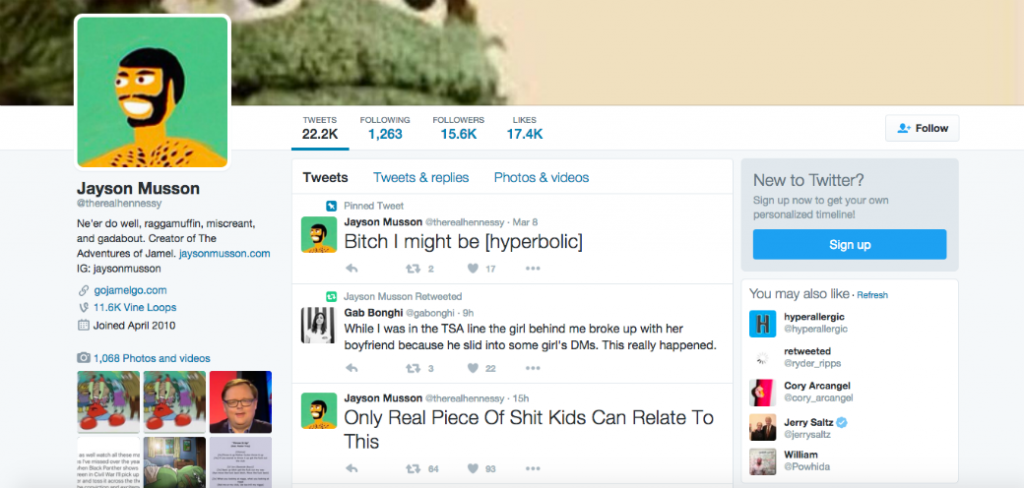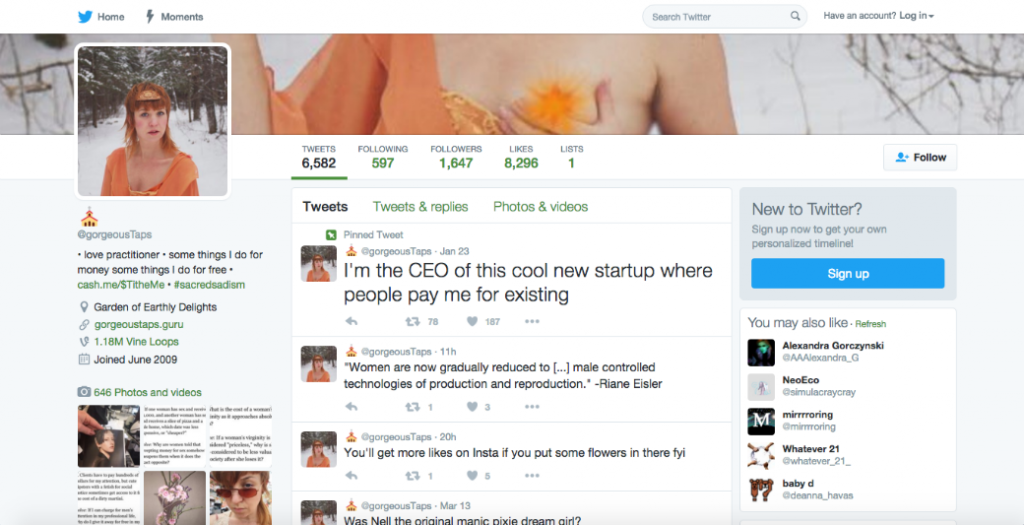
Jayson Musson on Twitter.
Twitter is dying. Okay, it’s supposedly dying. Or maybe it just hasn’t stayed relevant AF RN. The 140-character platform might be switching to an algorithmic feed—in contrast to its current chronological one—and nobody is tweeting as much anymore. All this translates to the one big fear: media death.
But less hyped have been the small deaths and rebirths that individual users have performed since Twitter began. When the platform debuted in 2005, nobody knew exactly how it would be used. The users themselves—amateur and professional journalists, celebrities, artists, @horse e_books, political activists, and so on—have shaped what the medium has become, from a haven for anonymous trolls to an always-on source for news. The language has changed, too—hashtags are still in use, subtweeting has become a game of skill—but does anyone use “OH” anymore? These waves of use have rarely been documented, but bringing them to light shows just how integral Twitter users, including artist-users, have been to making Twitter what it is today.
Recently ART21 let me perform a very unscientific yet very thrilling—in fact, thrill AF—adventure in e-musing on and e-interviewing three artists who use Twitter all the time and have also renewed their Twitter personas and habits from time to time. Jayson Musson (@therealhennessy) is an artist who came to Internet fame with his “ART THOUGHTZ” YouTube videos, in which he performed the role of Hennessy Youngman, but he has since developed an extensive practice in painting, object-making, and collaborative video-making. Genevieve Belleveau (@gorgeoustaps) has a cosmic Twitter feed full of spiritual aphorisms that parody and embrace the corporate branding of oneself—and she traveled across the country in a mobile monastery. Shawné Michaelain Holloway (@cleogirl2525), like all the artists interviewed, makes work across all types of digital platforms and pays particular attention to the codes, memes, and other frames of reference—like the visual vocabulary of camgirls—that undergird digital infrastructures.

Genevieve Belleveau on Twitter.
The most cosmic of the bunch, Belleveau, once referred to her tweets as the “New Ascetic.” But that’s not how she came to Twitter. Circa 2009, she was driving an ice-cream truck and used Twitter to promote her all-girl dream creamery on wheels. “I was working with a group of women who branded ourselves as ‘Queen Frostine,’ a fleet of female ice-cream drivers,” she says. “My nickname was ‘Punky’ and I called my shitty old truck ‘Betsy’ and tweeted as PunkyNBetsy.” And this was before 24/7 data enabled updating with ease: “I didn’t have a smartphone so I was texting tweets on a Motorola Razr.” Her concluding remark on this first step into Twitter? “It was corny as hell.”
We all took some awkward first steps into social media. I usually try to not insert myself into the articles I write, but it’s difficult when I’m part of this narrative about Twitter identity renewal. It’s personal. I came to Twitter in 2008, and I had no clue what to tweet about. I’m pretty sure most people’s early tweets were something like, “What am I doing here?” That was mine, but I must have deleted it at some point to seem a bit more artsy—and coded.
i’m at work. it’s richter time.
— Corinna Kirsch (@corinnakirsch) October 29, 2008
Mine was meant to be coded, to be part of an in-crowd who didn’t overshare but who would share just enough. This was back when “just enough” meant you could identify yourself by whatever you wanted and when remaining anonymous didn’t immediately signal that you were a troll. For the handful of nerds who’ll remember, I used the name of my first art blog, @hereisafantasy. The art bloggerati used their website names as handles (@starwarsmodern, @gregorg, and @artfagcity, among others), but this was not to last. These days, Twitter has become the type of place where professionalism tends to rule over playfulness. You want rawness, rowdiness, realness? Try Snapchat.
Holloway goes by @cleogirl2525. Handles like that are far less common; hers seems to hark back to the AOL days, of random-number generators when your preferred name was already taken. (Who was lucky enough to have @cleogirl?) Holloway has had multiple Twitter accounts over the years, all used for different purposes. “I did come back to Twitter after many years,” says Holloway. “I had to build up a new following almost from scratch with a new audience base in mind (art instead of local). I do nothing differently, even though I should be way more professional. I have guilt.” I was struck by Holloway’s affect of guilt. Maybe you feel it, too. There are no formal rules to Twitter, but there are codes of behavior for acting in public across different platforms. In 2016, the specter haunting Twitter is professionalism. It’s getting harder and harder to (cliché alert!) find your voice on the corporate ’net. “Hopefully I won’t ever get fired over a tweet,” added Holloway.
Yes, Twitter has always been a commercial platform, but that aspect has become more pronounced. “[B]rands/corporations [back then] hadn’t found their present savvy in occupying the platform/intruding on conversations,” says Jayson Musson, who first started using Twitter in 2008, “not just from the standpoint of creating and [the] ascension of the social-media manager.” “[There weren’t] any sponsored content or ads,” added Musson. “It also felt more barren, now that I think about it, as the smaller user base was much more pronounced.”
Although the Twitter user base did shrink in 2015, the larger that it has become, the more that individual Twitterers have had to refine—and re-refine—their identities.

Shawné Michaelain Holloway on Twitter.
“Claiming [that] I’m rebranding is one of my favorite types of tweets,” says Belleveau, “whether I end up following through or not.” Even two years ago, her tone was different: she was working on a different project, the Mobile Monastery, and was on a self-described “pretty lofty asceticism” trip, which she further describes as: “Big into broad strokes and statements of intent. Aphorisms, truisms and inspirational insights. No rants, no gossip, no subtweets.”
All three artists have changed their entire identities if not their tone. When Musson began using Twitter, it was through the voice of Hennessy Youngman, whose last published work was in 2012. Inevitably, he ended up changing to what he calls “normal Jayson.” “As time went on and the notion of performing through social media became too fatiguing,” he says, “I began using it for myself and there was a definite change in tone. Y’know, all caps tweeting to ‘normal Jayson’ self-loathing tweets, non-sequitur jokes, etc.” Basically, he says, it has become “more personal versus a soundboard for art-related musings.”
Is 2016 the year of the personal Twitter? Or the professional Twitter? Will the two duke it out in some sort of Hegelian dialectic, giving us a synthesis of the personal-professional? Will Twitter survive media death? Will any of us survive on Twitter? We just have to wait and see. But if we know one thing, in the years to come, Twitter will never be the same.




Pingback: Monday Links: The Inflatable Doll Gets It